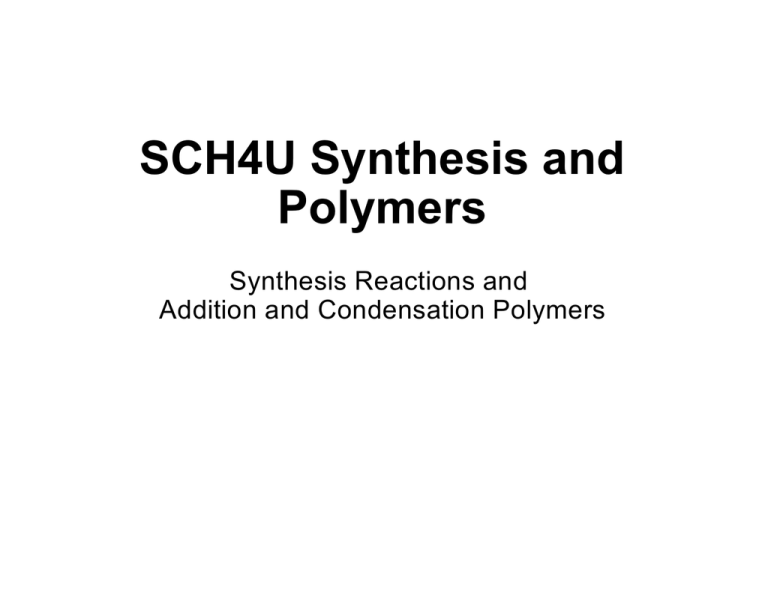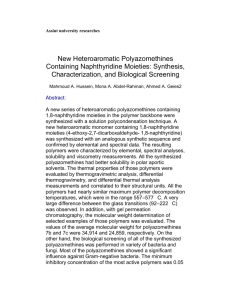SCH4U Synthesis and Polymers Synthesis Reactions and Addition and Condensation Polymers
advertisement

SCH4U Synthesis and Polymers Synthesis Reactions and Addition and Condensation Polymers ADDITION POLYMERS ADDITION POLYMERS A + A + A + A A monomers + + + A A polymer + ethylene (ethene) + A polyethylene linear + propylene (propene) many (n) monomers polypropylene nA (A) n polymer branched POLYMERISATION OF ALKENES ADDITION POLYMERISATION Process: alkene adds to itself • all the atoms in the original alkenes are used to form the polymer • long hydrocarbon chains are formed equation shows the original monomer and the repeating unit in the polymer n represents a large number ethene poly(ethene) MONOMER POLYMER POLYMERISATION OF ALKENES EXAMPLES OF ADDITION POLYMERISATION ETHENE PROPENE CHLOROETHENE VINYLCHLORIDE TETRAFLUOROETHENE POLY(ETHENE) POLY(PROPENE) POLY(CHLOROETHENE) POLYVINYLCHLORIDE PVC POLY(TETRAFLUOROETHENE) PTFE “Teflon” POLYMERISATION OF ALKENES SPOTTING THE MONOMER “Styrofoam” styrene Catalyst + could be as simple as a proton from sulfuric acid Catalyst + H 2 SO 4 or (+) cationic catalyst R resonance stabilized (+) (Markovnikoff) (+) R + + etc. Polystyrene POLYSTYRENE R n repeating unit COPOLYMERS Polymers which are formed by combining two different monomers in alternating fashion are called copolymers. A + B + A + B A B A B butadiene styrene styrene -butadiene rubber (SBR) THERMOPLASTICS Thermoplastics can be softened or melted by heat and reformed (molded) into another shape. Most addition polymers are thermoplastics. The polymer chains are held together by weak interactions (noncovalent bonds) such as : van der Waal's forces, London dispersion forces and Dipole -dipole attractions. These interactions are disrupted by heating, allowing the chains to become independent of each other. Heating and reforming can be repeated indefinitely (if degradation doesn't occur). This allows recycling. PLASTICIZERS Most polymers of high molecular weight are quite rigid. Can be softened and made flexible by adding plasticizers O C C O O CH 2 CH 2 CH 2 CH 3 O CH 2 CH 2 CH 2 CH 3 dibutyl phthalate The plasticizer separates the individual polymer chains from one another. It acts as a lubricant which reduces the attractions between the polymer chains. THERMOSET PLASTICS Thermoset plastics melt initially, but on further heating they become permanently hardened. Once formed, thermoset plastics cannot be remolded, and they cannot be recycled. On heating, thermoset plastics become cross -linked (covalent bonds form between the chains). The cross-linked chains form a rigid network heat linear cross-linked HIGH -DENSITY POLYMERS Linear polymers with chains that can pack closely together. These polymers are often quite rigid. LOW-DENSITY POLYMERS Branched -chain polymers that cannot pack together as closely. There is often a degree of cross -linking. These polymers are often more flexible than high density polymers. SOME COMMON ADDITION POLYMERS example monomer polymer polyethylene CH 2 CH 2 polypropylene CH 2 CH CH 2 CH 3 polystyrene CH 2 CH polyvinyl chloride CH 2 CH (PVC) Cl CH 2 CH 2 CH CH 3 CH 2 CH uses most common polymer bags, wire insulation, squeeze bottles fibers, bottles, indoor-outdoor carpet styrofoam, inexpensive molded objects: household items, toys synthetic leather, clear bottles, floor coverings, water pipe CH 2 CH Cl Teflon CF 2 CF 2 CF2 CF2 non-stick surfaces, chemically resistant items polyacrylonitrile CH 2 CH CH 2 CH fiber used in sweaters, blankets, carpets (Orlon, Acrilan) C N C N COMMON ADDITION POLYMERS (cont) example poly(methyl methacrylate) monomer polymer CH 3 CH 3 CH 2 C (Lucite, Plexiglass) poly(vinyl acetate) CH 2 (PVA) CH O C CH 3 O O CH 3 CH 2 C CH CH 2 CH 3 CH 2 C neoprene rubber adhesives, latex paints, textile coatings chewing gum CH 2 CH O C CH 3 natural rubber unbreakable glass, latex paint CO 2 CH 3 CO 2 CH 3 CH 2 C uses CH CH 2 the polymer is crosslinked with sulfur (vulcanization) Cl CH 2 C CH CH 2 Cl CH 2 C CH CH 2 cross-linked with ZnO, resistant to gasoline and oil Polymers and Polymerization RECYCLING CODES CODE SYSTEM FOR PLASTIC MATERIALS These codes allow consumers to separate plastics for recycling. 1 2 3 4 PETE polyethylene terephthalate soft drink bottles HDPE high-density polyethylene milk and beverage containers, products in squeeze bottles V polyvinyl chloride bottles with cleaning agents in them, some shampoo bottles LDPE low-density polyethylene thin plastic bags, plastic wrap PLASTIC MATERIALS CODE SYSTEM (cont) 5 PP polypropylene heavy-duty, microwavable containers used in the kitchen 6 PS polystyrene foam beverage cups, envelope windows 7 Other All other resins, multilayered materials, containers made of other materials ketchup bottles, snack containers, mixtures where the top differs from the bottom The codes are frequently stamped on the bottom of containers. CONDENSATION POLYMERS A DIFFERENT TYPE OF POLYMER NOT AN ADDITION POLYMER ! CONDENSATION POLYMERS Condensation polymers are copolymers made from more than one type of monomer. Many functional groups are used (instead of alkenes) and each type of monomer has a different functional group. When condensation polymers are formed, a small molecule (usually H 2 O) is often eliminated as each bond forms. HO Ethylene glycol O O C C OH Terephthalic acid H O CH 2CH 2 O O C C OH O CH 2CH 2 Dacron polymer O + H 2O SOME COMMON CONDENSATION POLYMERS CONDENSATION POLYMERS Examples Synthesis polyamides polyesters peptides starch (nylon) (terylene) reactions between Dicarboxylic acids and diols Dicarboxylic acids and diamines Amino acids ESTER LINK AMIDE LINK POLYAMIDES - NYLON -6,6 Reagents Equation hexanedioic acid hexane-1,6-diamine HOOC(CH2 )4 COOH H2 N(CH2 )6 NH2 n HOOC(CH2)4COOH + n H2N(CH2)6NH2 ——> -[NH(CH2)6NHOC(CH2)4CO] n- + n H2O Product Nylon-6,6 two repeating units, each with 6 carbon atoms Repeating unit —[-NH(CH2 )6 NHOC(CH2 )4 CO-]n — Properties contain a peptide (or amide) link can be broken down by hydrolysis the C-N bond breaks behave as amides biodegradable can be spun into fibres for strength Uses fibres and ropes PEPTIDES Amino acids join together via an amide or peptide link a dipeptide 2 amino acids joined 3 amino acids joined many amino acids joined dipeptide tripeptide polypeptide PROTEINS • polypeptides with large relative molecular masses (>10000) • chains can be lined up with each other • the C=O and N-H bonds are polar due to a difference in electronegativity • hydrogen bonding exists between chains dotted lines ---------- represent hydrogen bonding Interpeptide interactions, especially hydrogen bonds, lead to complex structures and folding patterns.








